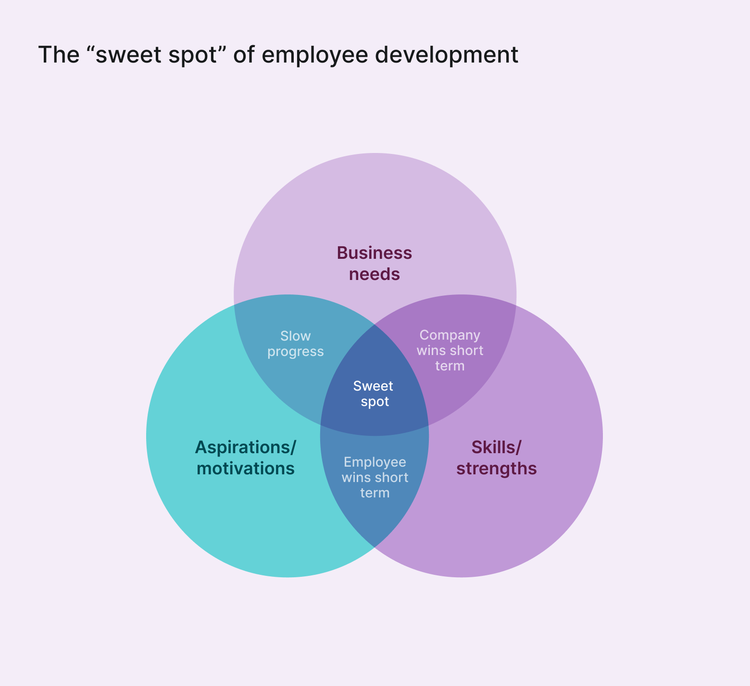
Aligning business needs to employee development goals

Written by

Lead People Scientist, Culture Amp
Employee development is one of the most powerful tools you have to motivate your team, improve retention, and boost productivity. When approached thoughtfully, it’s also a fantastic way to align individuals’ aspirations and interests with business objectives, creating a win-win for both your employees and your organization.
The key to effective development planning is finding the sweet spot where employees’ passions and career goals intersect with the needs of the business. As a manager, you have the unique opportunity to drive this alignment by helping your team set effective employee development goals that ensure both personal fulfillment and organizational success.
In this article, we’ll explore just how to create employee development goals that support your team’s career aspirations while keeping organizational objectives top of mind.
What are employee development goals?
Employee development goals are personalized objectives that push employees to improve their skills, adopt new behaviors, expand their knowledge, and gain meaningful experience. Ultimately, they can help your employees grow and reach the next level of their careers.
Employee development goals examples
Professional development looks different for every employee. Here are a few examples of what development could look like for your employees:
-
A junior employee aiming to enhance their marketing skills: This employee could focus on goals that build expertise and expand their industry knowledge, such as completing a certification in paid advertising or attending an industry-leading event marketing conference.
-
Employee development goals examples:
- Complete an online certification course in Digital Advertising by the end of this quarter.
- Attend the Event Marketing World Conference during Q3 to gain insights and network with at least 10 industry professionals.
- Deliver two 30-minute presentations to the team this quarter to share key takeaways and actionable ideas from my class/conference.
-
Employee development goals examples:
-
A senior sales representative hoping to become a manager: This individual might want to focus more on improving their soft skills, like communication, delegation, and leadership skills.
-
Employee development goals examples:
- Mentor 2-3 junior team members over the next six months, meeting biweekly to provide guidance and track their progress.
- Take ownership of two high-profile projects in Q1 to practice decision-making, delegation, and team management.
-
Employee development goals examples:
Development goals will vary for each employee, so as a manager, it's essential for you to understand their unique strengths, areas for improvement, and career aspirations. By tailoring goals to align with these factors, you can help employees create meaningful and impactful objectives that support both their growth and the organization’s larger plans.
Why are employee development goals important?
When used effectively, professional development goals can help your business:
- Build future leaders: These goals prepare employees for promotions or new responsibilities by developing their leadership, technical, or strategic abilities.
- Drive engagement and retention: Employees who see clear opportunities for growth are more motivated and committed to your organization.
- Support organizational success: By aligning employee goals with business objectives, you create a workforce that’s ready to meet current and future challenges.
- Increase profitability: According to Gallup research, organizations that prioritize employee development see an 11% increase in profitability compared to those that don't invest in their workforce's growth.
- Foster continuous learning: Development goals encourage employees to stay curious and continuously expand their knowledge and skills.
- Future-proof your organization: Employee development is essential for succession planning. It equips your workforce with the skills to adapt and thrive in a rapidly changing business landscape.
Why employee development goals need to align with business needs
While employees typically know where they want to go in their careers, they might need help figuring out how to get there. That’s where development goals and a manager’s guidance can help.
At Culture Amp, we’ve found that effective development goals combine three elements:
- Employee skills and strengths
- Employee aspirations and motivations
- Business needs
The “sweet spot” of development lies at the intersection of these three elements.

At this sweet spot, employee development goals:
- Motivate employees by playing to their strengths and their personal aspirations
- Help employees understand what the business is trying to achieve and how their individual growth fits into the picture
- Meet the company’s business needs
Achieving the optimal balance with effective goals
Finding this three-way balance can be tricky, but it’s worth the effort. Any imbalance can lead to negative outcomes for both individual and organizational growth. Let’s take a closer look at the potential consequences:
-
When a goal aligns with an employee’s aspirations and strengths but doesn’t address a business need
This situation can be frustrating for other team members who are being held accountable for reaching a business goal. It can also affect the employee’s performance assessment later that year. Encouraging your direct report to focus solely on their passions and strengths, without considering the broader business context, can ultimately hinder their chances for career advancement within your organization. -
When a goal incorporates an individual’s strengths and aligns with business needs, but doesn’t match the employee’s desires or aspirations
This can demotivate the employee. According to Culture Amp data, a lack of development/career advancement is the top reason employees leave a company. The wrong development goals can fuel employee turnover by pushing employees to look for growth opportunities outside of your organization to fulfill their ambitions. -
When a goal aligns with both a business need and an employee's aspiration, but doesn’t leverage the individual’s strengths
As a manager, you may face a situation where an employee is eager to pursue a growth opportunity that supports a business need but doesn’t align with their current skill set or strengths. For instance, an employee might want to transition into a role on a different team, despite lacking the necessary skills. While the role may not be a perfect fit for the employee at this time, you can partner with them to establish development goals that will help them build the required skills and industry knowledge needed to excel in their dream role. This approach allows the employee to grow and prepares them for similar opportunities that may become available in the future.
In the next section, we’ll explore a framework for guiding your employees towar development goals that balance all three elements.
Finding this three-way balance can be tricky, but it’s worth the effort. Any imbalance can lead to negative outcomes for both individual and organizational growth. Let’s take a closer look at the potential consequences:
Achieving this three-way balance can be tricky, but it’s essential. For example, if an employee’s development goal doesn’t meet a business need, it can be frustrating for other team members who are being held accountable for reaching a business goal. It can also affect the employee’s performance assessment later that year, which means that encouraging your direct report to focus only on their passions and strengths can actually deter their ability to move up in the organization.
Likewise, if a goal incorporates an employee’s strengths and aligns with business needs, but doesn’t match the employee’s desires or aspirations, then the employee may become demotivated. Culture Amp data has shown that lack of development and career progression is the #1 reason an employee leaves a company. The wrong development goals can fuel employee turnover by pushing employees to look for growth opportunities outside of your organization.
As a manager, you might run into a situation where an employee wants to pursue a growth opportunity that doesn’t align with a business need. For example, they may want to move into a different role, but there is no open role that matches their interests; or they may want to be promoted, but your company doesn’t have the additional budget to warrant a more senior role. How can you bridge the gaps between what your direct report wants and what the business asks for?
In the next section, we’ll explore a framework for guiding your employees towards development goals that do just that.
A proven framework for crafting employee development goals
As a people manager, it’s up to you to help align your direct reports’ needs and strengths with the overarching business strategy. While this might seem challenging, we’ve broken the process down into four straightforward steps for shaping growth goals that land in the “sweet spot” of development:
1. Understand your employees
Part of your job as a manager is to understand your direct reports. This includes learning their career advancement aspirations, strengths, areas of improvement, motivations, and so on. When you know your team well, you can be a better coach and manager, fostering the growth and passions of each of your direct reports.
How can you get to know your team better? Through surveys and 1-on-1s!
-
Using engagement surveys to understand and support employee development: The true value of employee surveys is collecting insights into overall employee satisfaction and highlighting specific development needs within your team. By analyzing survey data, you can pinpoint obstacles that may be limiting employee growth or motivation – such as unclear career paths or limited awareness of internal development opportunities. This allows you to take focused, strategic action to address those challenges and create a workplace culture that fosters learning, engagement, and career progression.
Learn more about conducting and analyzing engagement surveys and encouraging engagement survey participation in our complete guide to employee surveys. - Collecting employee feedback in 1-on-1s: Regular 1-on-1s are opportunities to build better relationships with your employees, identify their unique strengths, and uncover areas where they feel they need additional support or development. These conversations provide meaningful insights that enable you to tailor coaching efforts, create personalized development plans, and assign projects that align with employees’ skills, aspirations, and growth potential.
Questions to ask your employees:
- What are your biggest strengths?
- How do you think you can best contribute to our company goals?
- What types of projects do you enjoy working on?
- What do you want to achieve in the next stage of your career?
2. Understand your organization
In addition to learning about your direct report’s career advancement aspirations and strengths, be sure you understand your organization’s needs.
Start by asking your own manager and HR about the following key areas:
- Promotion eligibility: Be the best advocate for your direct report by knowing how and when to recommend an employee for a promotion.
- Internal job postings: Check if any current job postings might align with your team member’s interests or aspirations.
- Future hiring needs: Connect with other managers and peers in other cross-functional business areas to understand the company’s future hiring needs. That way, you’ll be aware of and prepared to recommend opportunities to your direct report.
- Lateral move opportunities: If you can’t offer an employee motivating growth opportunities on your team, see if there’s a possibility for them to grow in another area of your organization.
As a manager, you have a vantage point that your direct reports do not. Your goal is to understand the options and limitations so you can best help them navigate internal processes and connect them with the right people.
Questions to ask your HR team:
- What development opportunities exist in our organization?
- What is our process for hiring from within?
- What roles will we be hiring for in the coming months?
3. Understand the options
Growth doesn’t always have to come in the form of a promotion or lateral shift. Other types of career growth can be equally, if not more, rewarding and open up a wide variety of opportunities for your employees. So, before you move on to the employee goal-setting process, take the time to explore what learning and development opportunities your business offers.
At Culture Amp, we use the 3 E’s model – Education, Exposure, and Experience – to assist with development planning. Here’s a quick breakdown of the framework:
- Education: Any formal business-sponsored training or learning an employee wants to do to further their education, like enrolling in an online course or attending an industry conference.
- Exposure: Any learning that is done by observing or working alongside others, particularly mentors, coaches, or teammates, such as partnering with a more senior colleague to complete a project.
- Experience: There’s a common belief that “70% of learning comes from experience,” meaning that your employees need to practice skill development in real life in order to truly learn them. For example, while an employee may spend hours in a classroom learning UI or UX, the best way for them to fully grasp what they’ve learned is often to try a task themselves and practice.
While traditional classroom learning can be effective, learning via exposure and experience is often more impactful. Keeping this in mind, try to find opportunities around the organization that will allow your direct reports to learn from others and try new skills out first-hand. This might not have the same allure as a promotion, but these opportunities can provide purpose and meaningful growth.
Here are a few common ways to invest in employee development:
- Match employees with mentors: Introduce your employees to people who can provide guidance and encourage career growth.
- Leverage job shadowing: Have employees “shadow” employees on their team or around the organization to better understand different roles and responsibilities.
- Introduce stretch projects: Assign direct reports projects that inspire them to get out of their comfort zone and learn new skills.
- Try secondments: Encourage your employees to temporarily shift into another role, so they can see if it's a good match for their interests and skills.
- Enroll employees in internal training programs: Check if there are relevant training programs around the organization that your direct reports can attend.
- Use L&D stipends, if offered: Remind your employees to use their personal growth stipend to attend a conference, take a class, earn a certification, etc.
Questions to ask your HR team and other managers:
- What is the budget for learning and development?
- What can our L&D budget be used for?
- Do we have any internal mentorship programs?
- What internal training programs do we offer?
Once you’ve done your research and familiarized yourself with the above, it’s time to share this information with your employees and put a career development plan into action.
4. Create employee development goals and a path to follow
Then, find the “sweet spot” of development by connecting your employee’s aspirations and strengths to current business needs and opportunities.
How might this look in practice? Here’s an example:
Say you’re having a development conversation with an employee who mentions wanting to improve their project management skill development and become a Sr. Project Manager one day.
As a manager, you look for a way to map the employee’s strengths and professional goals to an important upcoming business project. For example, say your team has a significant project lined up for the next quarter. You can ask your employee if they’d like to take a more prominent role in the project to gain more project management experience.
Then, you can set up a bi-weekly meeting with a current Sr. Project Manager on your team so your employee can ask them questions about their job and get advice on the new project.
You also recall that your team’s quarterly budget has additional funds available, so you suggest to the employee that they explore a project management course to further develop their skills.
Moreover, you know that your business just signed a few large contracts with new clients. Demand for project management skills will increase in the coming months, so now is the perfect time to invest in this employee.
In this sample scenario, you’ve identified a way to align business needs and employee desires and leverage the “3 E’s model” to help shape your direct report’s development goals.
- Education: The employee will enroll in an online project management course to enhance their skills and knowledge.
- Exposure: The employee will have bi-weekly meetings with an internal mentor to gain insights and learn from their expertise.
- Experience: The employee will take on a leadership role in an upcoming project, providing them with the hands-on experience they need to refine their skills.
Now, it’s time to put pen to paper. For example, a good development goal might be “Become a stronger project manager.” You can use this goal to evaluate the individual’s overall performance objective (e.g., “Serve as the lead project manager on Q3 project for X company.”)
The purpose of an employee development goal is to give employees an understanding of what success looks like and the steps they can take today to achieve their personal and professional targets. You can even tie professional goals directly to performance goals to improve accountability and motivate employees to do their best.
Remember that professional development is an ongoing process. The work isn’t over once your direct reports have set their goals – in fact, it’s just beginning. Meet frequently with your employees as they pursue their goals. During weekly or bi-weekly 1-on-1s, share feedback and goal progress, identify blockers, and work together to build development into your employee’s day-to-day.
Make employee development personalized, simple, and effective
As a manager, you’re responsible for juggling the best interests of your employees and the organization – which is no small feat. Luckily, you don’t have to go about it alone. Here are some tools you can use to improve employee development:
1. Leverage technology to create tailored growth plans
Technology can be a game-changer in creating personalized development plans for your employees. Culture Amp’s personalized growth plans make it easy to identify your employee’s desired next role, create clear development goals, identify growth areas, and share continuous feedback. With all this information in one tool, employees can clearly understand what they need to accomplish to reach the next level in their careers.
2. Streamline employee goal-setting with actionable templates
Are your employee’s goals truly SMART?
You can be confident they are when you use structured templates that guide both employees and managers in setting clear, actionable objectives. Culture Amp’s goal-setting software has templates to help you define measurable goals, set specific timelines, outline key results, and align individual goals with broader team and business objectives. Additionally, you can control the visibility of goals, allowing employees to track their progress publicly or privately. By setting effective goals, storing them in a centralized location, and continuously monitoring progress, you foster accountability and keep development top of mind throughout your review period.
3. Turn 1-on-1s into coaching opportunities
With so much to cover in weekly 1-on-1s, professional development can sometimes take a backseat. As a manager, it’s your responsibility to help employees keep development goals and progress front and center throughout the quarter.
Make time in 1-on-1s to provide meaningful feedback and coach employees effectively, ensuring they prioritize their growth and make continuous progress. Using a shared meeting agenda, like the one in Culture Amp’s 1-on-1 conversations tool, can serve as a helpful reminder to share development updates, discuss setbacks, and offer feedback, keeping both you and your employee focused on their growth.
Measuring the impact of employee development goals
Employee development initiatives are only as effective as the results they produce. To ensure your efforts drive meaningful change, it’s essential to measure the impact of development goals and adjust your strategies based on the insights gained.
Here are a few ways your business can evaluate the success of its employee development initiatives. Consider tracking:
- Employee surveys: Ask employees how they perceive development and growth within your organization and track their responses over time. You can use engagement surveys, pulse surveys, and post-training feedback surveys to assess whether employee satisfaction and sentiment are changing for better or worse.
- Training program attendance: The percentage of employees completing development programs or earning certifications.
- Skills assessments: Have employees complete skills and knowledge assessments before and after training programs. This can help your business track progress and quantify improvements.
- Promotions: Analyze internal mobility rates to determine the percentage of employees receiving promotions or transitioning to new roles within the organization. This can provide insight into the effectiveness of your development programs in preparing employees for new challenges and responsibilities.
- Technology adoption: Do you use a technology solution to help with goal setting, sharing feedback, and learning and development? Track employee and manager participation rates to understand how engaged your team is with the tool.
- Stay and exit interviews: These formal conversations provide valuable qualitative insights and employee feedback into your workforce’s perceptions of growth opportunities within your organization.
- Employee retention: Monitor turnover rates among employees who participate in your development programs versus those who do not. Effective development programs play a key role in boosting retention by making employees feel valued and helping them identify growth opportunities within the company.
- Business performance: As mentioned earlier, an investment in development can be tied to better business results. Try tracking changes in business outcomes to see if your development initiatives are associated with increased revenue, reduced costs, higher customer satisfaction, or improved operational efficiency.
Collectively, these data points and metrics provide valuable insights into how employees perceive development and growth opportunities within your organization. They help identify what you’re doing right and where you can improve, enabling your business to take targeted action. By addressing any gaps, you can enhance employee satisfaction, foster growth, and retain top talent before they seek new opportunities elsewhere.
Drive employee development with Culture Amp
Grow and retain your top-performing employees with Culture Amp Develop. Store career paths and competencies, use analytics to gain visibility into employee development, and develop individual development plans – all in one easy-to-use platform. Inspire every employee with growth opportunities that keep them engaged, motivated, and performing at their best.
Request a demo of Culture Amp Develop today to see the tool for yourself and take the first step toward investing in your employees’ growth and success.

Support your employee’s career aspirations
Learn how to have more productive growth conversations and start making meaningful changes that empower your people.



